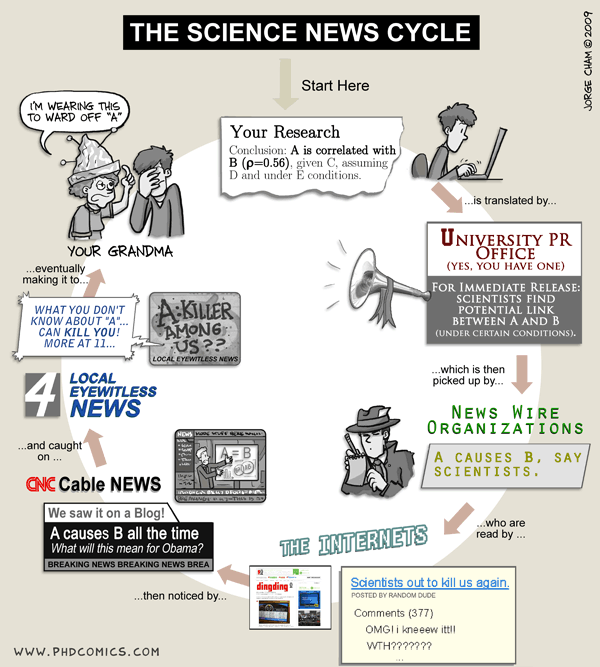That the media distorts scientific findings is not a new observation.

As this PhD Comic suggests, there is a long and rich history of the media sensationalizing small findings, giving them dire or miraculous consequences that never appeared in the initial study.
However, the election makes such reporting seem not only unethical but downright dangerous. It is clear that the administration means to control science narratives by tactics such as removing all references to climate change from government websites.
As we teach digital literacy in our classrooms, we often focus in on finding expert sources. But in terms of science, what happens if expert sources — such as government reports on climate findings — are more concerned with narrative than facts?
This lesson plan is meant to help first year writing students engage with the fact that science can have narratives. During the first day of this lesson, I received pushback. My students were unconvinced. They countered with, “Surely science is just facts, and, as such, the truth will always rise to the top.”
However, over the course of a week, the activities will helped my students understand that science is both rhetorical and political. By the time the week was over, my students were talking about science — and rhetoric — in a whole new way. They built their own database of knowledge, ending the week with a guide for others about how to engage with science in the age of alternative facts and fake news.
Lesson Plan: Reading Science News Rhetorically
This plan assumes a class that meets 3-times per week, approximately 50 minute classes. For a twice-weekly course, have them read the Ceccarelli article before the first day of class and build the discussion and initial investigations into manufactured controversies into that first day.
Day One: Science is Rhetorical — and Political
5 minutes: Brainstorming. Ask the class what they think of when they think of science. Have them write for five minutes.
10 minutes: Split into groups. Have students share their thoughts and between them, come up with a list of the five main characteristics of science. Have them write these characteristics on the board or in a shared google doc. Discuss characteristics in the full group — specifically looking for any ideas that might contradict. Likely, these characteristics will include ideas like objectivity, the scientific method, unbiased, fact-based, or similar highly rational, binary thinking.
20 minutes: With these binary ideas about objectivity in mind, have students watch John Oliver’s coverage on science reporting. Guiding questions while watching: Is the media to blame for making science seem less reliable? Can we really not choose what we want to believe in? Are facts facts no matter what?
15 minutes: Talk about how the video challenges the way we might think about science functioning in society. It might be helpful to have them brainstorm the sorts of places they run into science/medicine, and how that affects their lives. Are there times when facts seem less important?
Homework: Assign introduction of Lean Ceccarelli’s “Manufactured Scientific Controversy”
Day Two: Manufacturing Scientific Doubt
5 minutes: Brainstorming. What was Ceccarelli’s main point in her essay? Do you agree that we should rely solely on scientific consensus?
10 minutes: In small groups and then whole group, work on defining key terms in Ceccarelli’s article. Class can generate list of key terms, but consensus and manufactured controversy should definitely be among them.
20 minutes: Break students into groups to look at how people or corporations manufacture doubt in science. Artifacts to investigate can include:
• NIPCC (Climate Change Denial): http://climatechangereconsidered.org/
• Antivax: http://www.stopmandatoryvaccination.com/
• Answers in Genesis (Young Earth Advocates): https://answersingenesis.org/
You’ll want to guide this group to focus in on the Young Earth aspect, as there is a lot of other stuff going on on this site. You could also use this site to investigate creationism vs evolution.
Guiding questions:
- How does each group create credibility (ethos)? How do they persuade their audience?Encourage them to think big picture. It’s not just about citations. How does the website look? What’s the url? What sort of experts do they use? Etc
- Does this feel like controversy? Or does it just seem like another way of looking at the facts? What’s at stake in this conversation?
- How would the average reader know if this was manufacturing doubt/controversy or reporting real scientific facts?
15 minutes: Have groups share findings and discuss similarities/differences across artifacts.
Homework: Assign each student to come in with a misleading/fake/alternative fact news story.
Day Three: Tackling the News
5 minutes: Brainstorming. Was it difficult to find a misleading or fake news story? How did you know that it story was false?
10 minutes: In groups, have students compare their news stories. Like the analysis of the previous day, have them talk what the hallmarks of the articles they found. What similarities can they find? What seem to be the most successful rhetorical moves?
20 minutes: Now to put all this higher order thinking into action. Instruct groups to make an infographic/fact sheet/video storyboard to help others know how to spot fake/misleading news about science. They should think about it as something to be shared in social media. How can they help arm their fellow citizens against the tricky, insidious nature of fake science/politicization of science?
10 minutes: Share project with the rest of the class. Talk about rhetorical choices — why this mode, why these words/design/layout etc.
5 minutes: Exit slip writing. After this week, how have their opinions on science changed?
